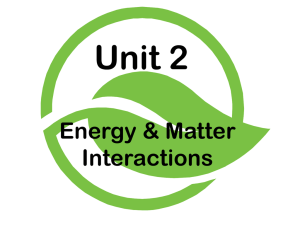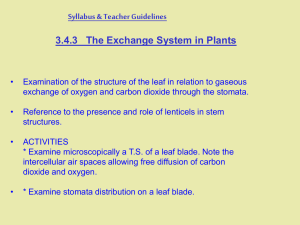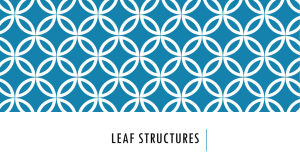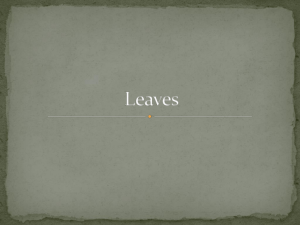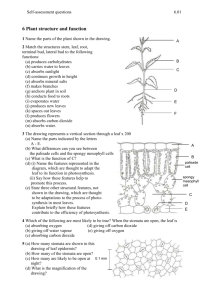3.4.5 Plant Excretion – What you will need to Objectives
advertisement
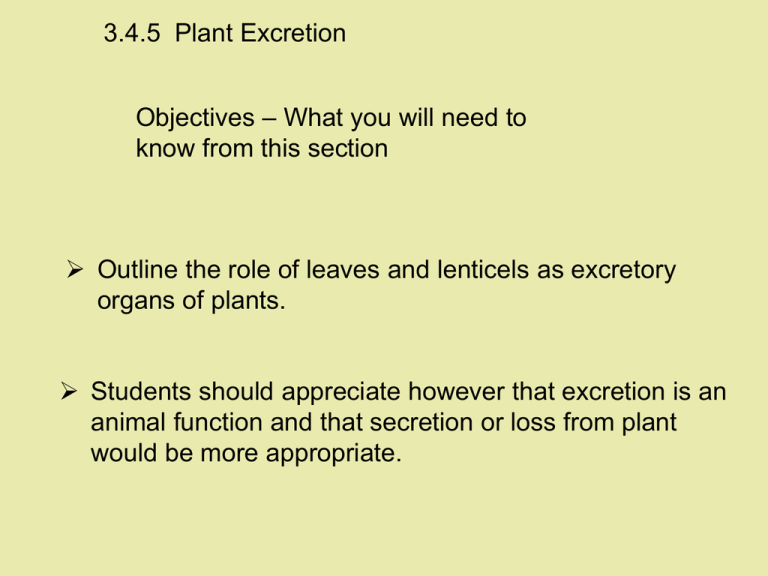
3.4.5 Plant Excretion Objectives – What you will need to know from this section Outline the role of leaves and lenticels as excretory organs of plants. Students should appreciate however that excretion is an animal function and that secretion or loss from plant would be more appropriate. 3.4.3 The Structure of an Exchange System in Flowering Plants Plants absorb water through their roots, but lose water from their leaves by evaporation (transpiration). Over 90% of the water that enters a leaf goes right on through it and evaporates into the surrounding air. The evaporation of water from leaves [and stems] is called transpiration. In plants, cells become specialised into one of three tissue types—dermal, ground and vascular. LEAF TS Dermal Tissue forms and protects the surfaces of the plant. Waxes coat the outermost cell wall, forming a cuticle—this cuts down water loss and is a barrier to attacks by germs or insects. Four things are needed for photosynthesis: SUNLIGHT Gives the plant energy CHLOROPHYLL WATER Travels up from the roots CARBON DIOXIDE Enters the leaf through small holes on the underneath The green stuff where the chemical reactions happen LEARNING CHECK • • • • • • • Plants absorb water from where? Plants can lose water from where? What is evaporation? What is transpiration? How do plants try and reduce water loss? What do plants need for photosynthesis Where does most photosynthesis take place? Structure of the Leaf Lots of chlorophyll Large surface area Transparent Thin structure Packed with chloroplasts Network of veins Lots of air spaces Holes Covering the epidermis of the leaf is a cuticle, which reduces the loss of water. A leaf’s veins are vascular tissue— xylem transports water and phloem carries sugars. Ground Tissue is photosynthetic, with large air spaces between the cells, to allow rapid diffusion of gases Leaf structure: The epidermis of stems and leaves have many holes [stomata] to allow for gas exchange. O2 is excreted as a by-product of Photosynthesis CO2 and H2O are excreted as by-products of Respiration The loss of water is reduced by a waxy cuticle and by the closing of the stomata [pores] on the lower surface of the leaf at night-time. Water loss Water loss through the stomata is biggest on a hot, dry, windy day. Plants that live in these conditions often have a thicker waxy layer. The stomata stay open during the day so that CO2 can enter, for photosynthesis. But, water can escape at this time too. Stomata can stay closed at night, when there is no light for photosynthesis. This allows plants to conserve water. Controlling water loss Carbon dioxide enters a leaf through the ________. These cells are also responsible for controlling the ______ content of the leaf… The ______ cells control how wide the stomata opens (if at all). If too much water is being lost through the stomata then the guard cells will _____ to prevent further loss. Water and carbon dioxide pass through here No more water and carbon dioxide allowed through What about trees and woody plants ? How do gases [oxygen and carbon dioxide] get through the waterproof, corky surface of bark? They do so through lenticels, which are areas where the packing of bark cells is loosened up a bit. Lenticels often look like tiny raised blisters on a branch or twig. Winter twig – showing lenticels LEARNING CHECK • Explain the roles of the cuticle and stomata in a leaf. • What environmental conditions result in a high transpiration rate? • Why are stomata open during the day, but closed at night? • What are lenticels? • How are lenticels different from stomata?
